
Kensington is a town in Montgomery County, Maryland, United States. The population was 2,122 at the 2020 census. Greater Kensington encompasses the entire 20895 ZIP code, with a population of 19,753 in 2020.

Darnestown is a United States census-designated place (CDP) and an unincorporated area in Montgomery County, Maryland. The CDP is 17.70 square miles (45.8 km2) with the Potomac River as its southern border and the Muddy Branch as much of its eastern border. Seneca Creek borders portions of its north and west sides. The Travilah, North Potomac, and Germantown census-designated places are adjacent to it, as is the city of Gaithersburg. Land area for the CDP is 16.39 square miles (42.4 km2). As of the 2020 census, the Darnestown CDP had a population of 6,723, while the village of Darnestown is considerably smaller in size and population. Downtown Washington, D.C. is about 22 miles (35 km) to the southeast.

Kensington is a passenger railroad station at 10417 Howard Avenue in Kensington, Maryland, United States. Opened by the Baltimore and Ohio Railroad (B&O) in 1891, the Kensington station is today served by MARC Train's Brunswick Line, which makes 15 weekday scheduled stops at Kensington, plus one flag stop on Fridays.
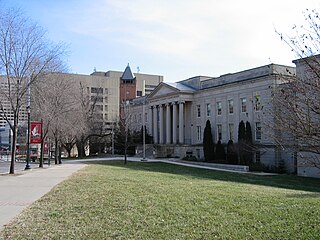
The Montgomery County Circuit Courthouses are part of the Montgomery County Judicial Center located in downtown Rockville, Maryland. The Red Brick Courthouse, located at 29 Courthouse Square, houses the refurbished Grand Courtroom; the newer Circuit Court building, located at 50 Maryland Avenue, houses the remainder of the county's justice system.

The Polychrome Historic District is a national historic district in the Four Corners neighborhood in Silver Spring, Montgomery County, Maryland. It recognizes a group of five houses built by John Joseph Earley in 1934 and 1935. Earley used precast concrete panels with brightly colored aggregate to produce the polychrome effect, with Art Deco details. The two-inch-thick panels were attached to a conventional wood frame. Earley was interested in the use of mass-production techniques to produce small, inexpensive houses, paralleling Frank Lloyd Wright's Usonian house concepts.

The Beall–Dawson House is a historic home located at Rockville, Montgomery County, Maryland, United States. It is a 2+1⁄2-story Federal house, three bays wide by two deep, constructed of Flemish bond brick on the front facade and common bond elsewhere. Outbuildings on the property include an original brick dairy house and a mid-19th century one-room Gothic Revival frame doctor's office which was moved to the site for use as a museum. The house was constructed in 1815.

The Bingham-Brewer House is a historic home located at Rockville, Montgomery County, Maryland, United States. It is a two-story, Federal style brick house, with a Flemish Bond front facade, dating to 1821. Also on the property is a late-19th century smokehouse, privy, and a late-19th or early-20th century chicken house.

Clifton is a historic home located at Ednor, Montgomery County, Maryland, United States. It is a 1+1⁄2-story gambrel-roofed brick structure with a lower north wing, also with a gambrel roof. Outbuildings on the property include a wood-frame shed and a guest house or cottage. It is one of the few extant mid-18th-century buildings in Montgomery County and is associated with the local Quaker community, which by 1753 had been organized into the Sandy Spring Meeting of Friends.
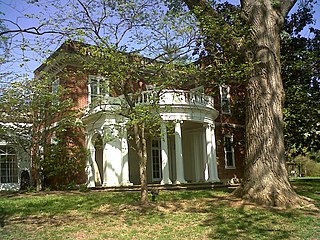
Woodend is a historic home located in the Montgomery County, Maryland, town of Chevy Chase. This Georgian Revival house was built by Chester and Marion Wells in 1927–1928, and owned by the Audubon Naturalist Society of the Central Atlantic States. It is a 2+1⁄2-story house with Flemish bond brick walls and brick quoins. The house was designed by John Russell Pope.
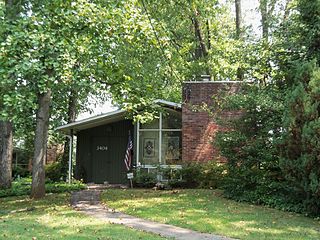
The Hammond Wood Historic District is a national historic district located at Silver Spring, Montgomery County, Maryland. It consists of 58 Contemporary single-family houses, built between 1949 and 1951, nestled in a tract of heavily wooded, rolling land. It is an intact, architecturally cohesive example of Charles Goodman's merchant builder subdivisions in Montgomery County.

The Poolesville Historic District is a national historic district located at Poolesville, Montgomery County, Maryland. It consists of 33 buildings of local architectural and historical significance including structures representing a diversity of styles, materials, and uses, and includes residential, ecclesiastical, and commercial architecture, as well as an assorted number of small domestic dependencies, such as dairies and smokehouses.

The Rock Creek Woods Historic District is a national historic district located north of Kensington, Montgomery County, Maryland. This suburban development, consisting of 74 Contemporary houses, is nestled in a wooded valley between two creeks near Connecticut Avenue. These houses were designed by Charles Goodman and built between 1958 and 1961 by Herschel and Marvin Blumberg, developers of New Town Center in nearby Hyattsville, Maryland. The original layout, including roads, lot configurations, and sidewalks, remains unaltered. During the 1960s, the neighborhood was home to a significant Jewish population and many people in the neighborhood were active in liberal causes, particularly the peace movement.

The Takoma Park Historic District is a national historic district located at Takoma Park, Montgomery County, Maryland. The district area was platted in 1883 by developer Benjamin Franklin Gilbert, and promoted for its natural environment and healthy setting. Originally an early railroad suburb, the opening of streetcar lines led to the expansion of the district in the early 20th century. Takoma Park houses built between 1883 and 1900 are fanciful, turreted, multi-gabled affairs of Queen Anne architecture with Stick Style and Shingle Style influence. Buildings developed after the turn of the 20th century tend to be 1-2 story brick structures with simple ornamentation, although a few display characteristics of such styles as Art Deco and Tudor Revival.
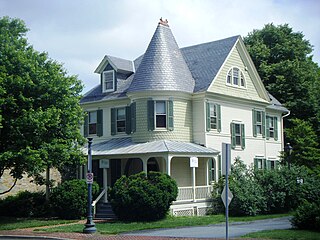
The West Montgomery Avenue Historic District is a national historic district located at Rockville, Montgomery County, Maryland. It is a residential area with single-family homes predominating. The majority of the properties within the district date from the 1880s, with a few older homes and somewhat more from later periods. The predominant character of the district is set by the rows of Victorian houses built between 1880 and 1900 in a vernacular residential mode with Eastlake and Stick Style influences. Also included in the district are attorneys' offices; churches and parsonages; a funeral home; the former Woodlawn Hotel, later called the Chestnut Lodge Sanitarium ; and the headquarters of the Montgomery County Historical Society.
Walker Prehistoric Village Archeological Site is an archeological site located near Poolesville, Montgomery County, Maryland. The site is a large Late Woodland village located on Selden Island in the Potomac River. Excavations carried out in the 1930s and 1940s revealed a 40-foot section of a palisade, circular house patterns, shallow oval pits and cylindrical pits, and flexed burials interred in the floors of the houses.

The Savage Mill Historic District is a national historic district located at Savage, Howard County, Maryland. The district comprises the industrial complex of Savage Mill and the village of workers' housing to the north of the complex.

The Washington Street Historic District is a national historic district named after George Washington in Cumberland, Allegany County, Maryland. It is an approximately 35-acre (140,000 m2) residential area to the west of downtown Cumberland and consists primarily of six blocks of Washington Street. It contains large-scale 19th- and 20th-century houses representing most of the major architectural styles, including examples of Greek Revival, Italianate, Gothic, Queen Anne, Romanesque, Colonial Revival, and bungalow. Also included in the district are the 1890s Romanesque courthouse, the 1850s Greek Revival academy building, and the Algonquin Hotel. It was listed on the National Register of Historic Places in 1973.
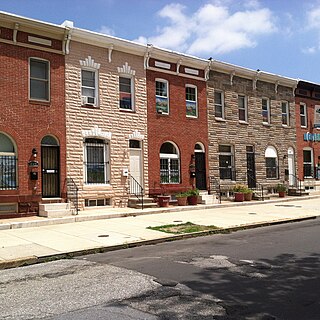
East Monument Historic District or Little Bohemia, is a national historic district in Baltimore, Maryland. It is a large residential area with a commercial strip along East Monument Street. It comprises approximately 88 whole and partial blocks. The residential area is composed primarily of rowhouses that were developed, beginning in the 1870s, as housing for Baltimore's growing Bohemian (Czech) immigrant community. During the late 19th and early 20th centuries the neighborhood was the heart of the Bohemian community in Baltimore. The Bohemian National Parish of the Roman Catholic Church, St. Wenceslaus, is located in the neighborhood. The historic district includes all of McElderry Park and Milton-Montford, most of Middle East and Madison-Eastend, and parts of Ellwood Park.

Old Laurel High School is a historic former school building on Montgomery Street in Laurel, Maryland. Built in 1899, it was the original home of Laurel High School, and now houses a community center.

Forest Glen Park is an unincorporated community in Montgomery County, Maryland and a residential neighborhood within the Silver Spring census-designated place. The community is adjacent to Rock Creek, Rock Creek Regional Park, and to the United States Army's Forest Glen Annex.























